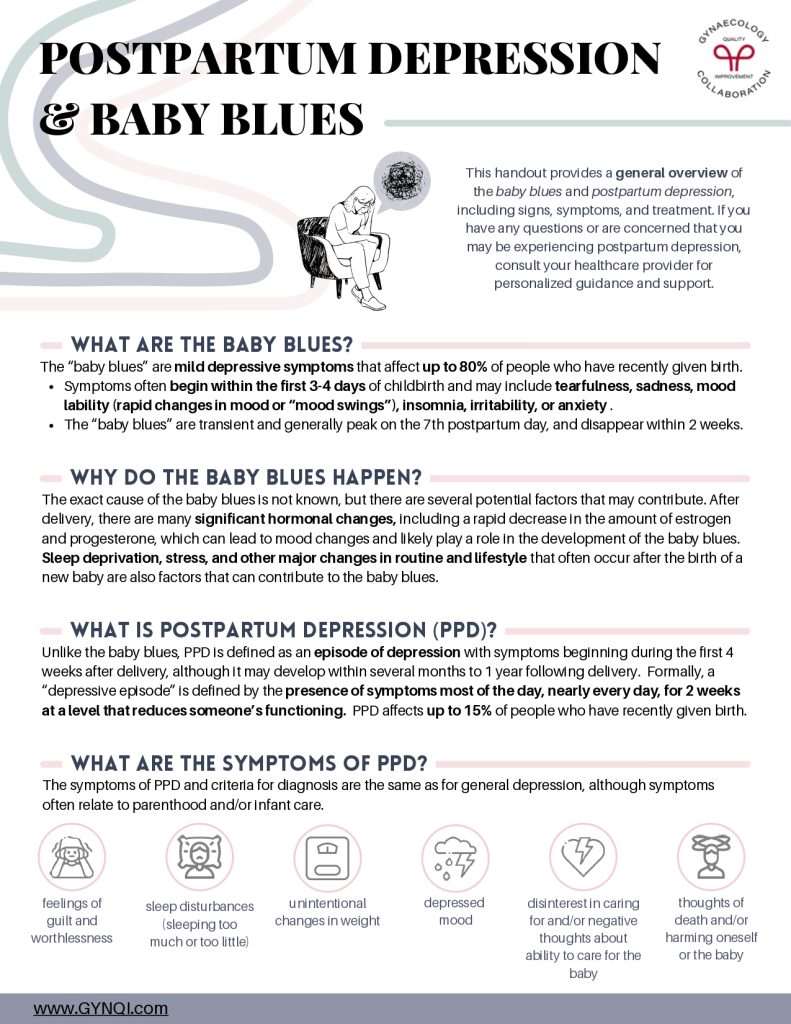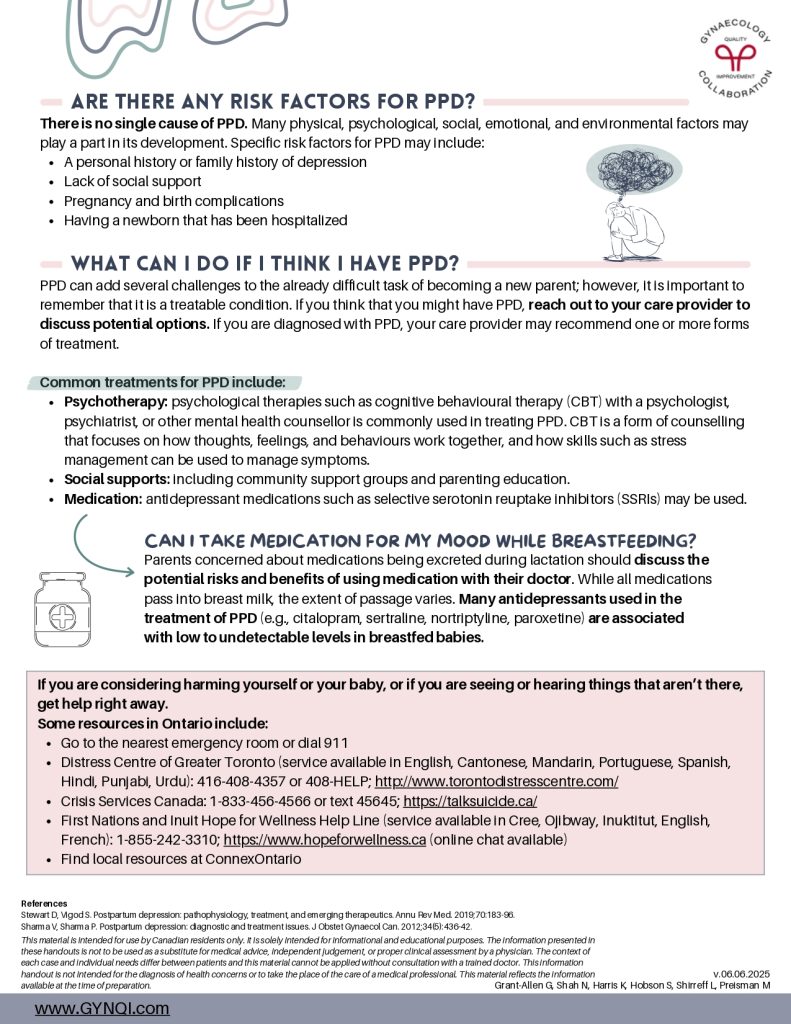
Postpartum Depression & Baby Blues
This handout provides a general overview of the baby blues and postpartum depression, including signs, symptoms, and treatment. If you have any questions or are concerned that you may be experiencing postpartum depression, consult your healthcare provider for personalized guidance and support.
What Are the Baby Blues?
The “baby blues” are mild depressive symptoms that affect up to 80% of people who have recently given birth.
- Symptoms often begin within the first 3-4 days of childbirth and may include tearfulness, sadness, mood lability (rapid changes in mood or “mood swings”), insomnia, irritability, or anxiety .
- The “baby blues” are transient and generally peak on the 7th postpartum day, and disappear within 2 weeks.
Why Do the Baby Blues Happen?
The exact cause of the baby blues is not known, but there are several potential factors that may contribute. After delivery, there are many significant hormonal changes, including a rapid decrease in the amount of estrogen and progesterone, which can lead to mood changes and likely play a role in the development of the baby blues. Sleep deprivation, stress, and other major changes in routine and lifestyle that often occur after the birth of a new baby are also factors that can contribute to the baby blues.
What Is Postpartum Depression (PPD)?
Unlike the baby blues, PPD is defined as an episode of depression with symptoms beginning during the first 4 weeks after delivery, although it may develop within several months to 1 year following delivery. Formally, a “depressive episode” is defined by the presence of symptoms most of the day, nearly every day, for 2 weeks at a level that reduces someone’s functioning. PPD affects up to 15% of people who have recently given birth.
What Are the Symptoms of PPD?
The symptoms of PPD and criteria for diagnosis are the same as for general depression, although symptoms often relate to parenthood and/or infant care.
- Feelings of guilt and worthlessness
- Sleep disturbances (sleeping too much or too little)
- Unintentional changes in weight
- Depressed mood
- Disinterest in caring for and/or negative thoughts about ability to care for the baby
- Thoughts of death and/or harming oneself or the baby
Are There ANy Risk Factors for PPD?
There is no single cause of PPD. Many physical, psychological, social, emotional, and environmental factors may play a part in its development. Specific risk factors for PPD may include:
- A personal history or family history of depression
- Lack of social support
- Pregnancy and birth complications
- Having a newborn that has been hospitalized
What Can I Do If I Think I Have PPD?
PPD can add several challenges to the already difficult task of becoming a new parent; however, it is important to remember that it is a treatable condition. If you think that you might have PPD, reach out to your care provider to discuss potential options. If you are diagnosed with PPD, your care provider may recommend one or more forms of treatment.
Common treatments for PPD include:
- Psychotherapy: psychological therapies such as cognitive behavioural therapy (CBT) with a psychologist, psychiatrist, or other mental health counsellor is commonly used in treating PPD. CBT is a form of counselling that focuses on how thoughts, feelings, and behaviours work together, and how skills such as stress management can be used to manage symptoms.
- Social supports: including community support groups and parenting education.
- Medication: antidepressant medications such as selective serotonin reuptake inhibitors (SSRIs) may be used.
Can I Take Medication For My Mood While Breastfeeding?
Parents concerned about medications being excreted during lactation should discuss the potential risks and benefits of using medication with their doctor. While all medications pass into breast milk, the extent of passage varies. Many antidepressants used in the treatment of PPD (e.g., citalopram, sertraline, nortriptyline, paroxetine) are associated with low to undetectable levels in breastfed babies.
If you are considering harming yourself or your baby, or if you are seeing or hearing things that aren’t there, get help right away.
Some resources in Ontario include:
- Go to the nearest emergency room or dial 911
- Distress Centre of Greater Toronto (service available in English, Cantonese, Mandarin, Portuguese, Spanish, Hindi, Punjabi, Urdu): 416-408-4357 or 408-HELP; http://www.torontodistresscentre.com/
- Crisis Services Canada: 1-833-456-4566 or text 45645; https://talksuicide.ca/
- First Nations and Inuit Hope for Wellness Help Line (service available in Cree, Ojibway, Inuktitut, English, French): 1-855-242-3310; https://www.hopeforwellness.ca (online chat available)
- Find local resources at ConnexOntario




